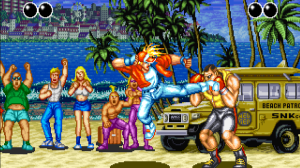Ever since it came out, Alan Moore’s Watchmen has been credited with (blamed for?) a shift in the way superhero comics are written and presented. Audiences responded to Watchmen‘s genre-savvy, complex, and self-aware storytelling as well as the gritty violence of the world its characters inhabited. Unable for a wide variety of reasons to recreate the lightning in a bottle that was Watchmen, a generation of comics creators have struggled to make their books more “realistic” and “adult,” with varying degrees of success. But in this week’s issue of Doomsday Clock, the impact that Watchmen and Doctor Manhattan have had on DC’s mythology is taken out of the realm of metaphor and into the very literal.
Videos by ComicBook.com
So, as you can imagine, spoilers ahead for Doomsday Clock #10, in stores now. In the issue, Doctor Manhattan relates his experience of becoming a supervillain. After leaving his own world, he found himself in the DC Universe, where he noticed the periodic changes being made to its history. As a being who is functionally immortal and can see the whole of history would be the ideal person to notice the sliding timeline that serialized monthly comics demands to keep up with the real world. Doctor Manhattan was there from 1938 until suddenly the “main” timeline was relegated to Earth-2 to make way for the next generation of heroes in the ’50s; through Crisis on Infinite Earths and Infinite Crisis and Final Crisis and a half-dozen other events that rewrote history as the denizens of the DC Universe know it.
Manhattan surmised that every major change to DC’s sprawling multiverse all emanated out of this one universe — an ever-changing and always dynamic reality he named the “metaverse.” It was by changing the metaverse that he was able to affect changes across the whole multiverse, and an addiction to making those changes, to having those godlike ripples coming from his fingers, is what makes him see himself, now, as a villain.
The exact nature of the changes he has made is not yet clear. Certainly the idea of the Supermen Theory — a conspiracy that says the US government is responsible for a lot of the world’s superheroes — is something that could have ties to Doctor Manhattan. He was created in a government lab and, like purported government stooge Metamorpho, has transmutation powers. The one thing we do know is that he removed the Justice Society of America. That is a key element of the story, and one that will presumably be resolved by the end, since Johnny Thunder still remembers his old teammates.
In the meantime, the main DC Universe timeline is known as the Metaverse. Whether this will last any longer than concepts like Hypertime (introduced in The Kingdom) or the modified post-Crisis on Infinite Earths reality of Convergence (we still haven’t seen where those versions of Barry and Kara went!), is anybody’s guess.
Doomsday Clock #11 is expected to be on sale on August 14.








